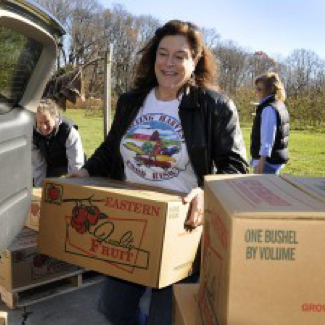An Article Published in the Courier Times and PhillyBurbs.com by Amanda Cregan, on November 22, 2012.
A donated box of macaroni and cheese or canned soup will put dinner on the table, but it does little to enhance nutrition.
A partnership between a group of volunteers and local farms aims to add to those dinner plates by connecting fresh, locally grown produce with neighbors in need.
As she stocked the shelves at Fisherman’s Mark food pantry, volunteer Cathy Snyder noticed something was missing.
Apart from the occasional overripe bananas donated by a local grocery store, fresh produce was consistently absent from the Lambertville, NJ food pantry, which serves needy families in the New Hope-Solebury community.
“Are we really making a difference when people are taking home mac and cheese and frozen chicken and canned food that is 40 percent sodium. Sure, it’s calories. I just thought we should do better,” said Snyder, of Solebury.
At the same time, Snyder discovered that local farmers were allowing their surplus produce to rot in the fields. Though farmers are willing to donate, they lacked the time and direction as to where to deliver their extra goods.
With an oversized SUV and passion for change, Snyder became that link.
Three years later, her nonprofit organization, Rolling Harvest Food Rescue, partners with a dozen farms to deliver seasonal produce to more than 20 food pantries, domestic violence centers, soup kitchens, homeless shelters and low-income senior housing facilities within a 25-mile radius of New Hope.
Since its beginnings in 2009, Rolling Harvest has delivered more than 80,000 pounds of fresh fruits and vegetables to local sites that help more than 12,000 people each month.
“It’s really a model that has made such a difference,” said Snyder, who is helped by about 30 volunteers.
On a recent Tuesday, Snyder and her team were making their rounds to farms to pick up white and sweet potatoes, mixed salad greens, turnips, apples and butternut squash.
At None Such Farm, farmers fill a weekly pallet of Rolling Harvest donations. That week, the Buckingham Farm had white potatoes and butternut squash waiting for the volunteers.
“We were really searching for a mechanism to be able to donate our extra produce,” said Karen Yerkes, co-owner of the farm.
When the weather cooperates, the harvest is bountiful, and there is always plenty left over to share with those in need, she said.
“To have Cathy transport that produce is of tremendous value,” said Yerkes.
As jobs and wages have been cut during the recession, food pantries are struggling under increased demand.
“What happened with this economic downturn and unemployment — the face of hunger is changing. There are middle-income people who can’t make it work. There are people who are working two jobs. There are people who are homeowners, who are driving up in their Cadillacs and they are going into food pantries,” said Snyder.
The number of families served at area food pantries is up 30 percent, but donations are down by 15 percent, she noted.
Just as the middle class struggles, so too do the poor. Low-income seniors, mothers with young children, disabled people, and people working minimum wage in local restaurants and shops are all leaning on pantries for help.
“I was really shocked and clueless about the poverty and hunger that what was in my own backyard,” said Snyder.
She hopes healthier options on their dinner tables will make a difference for needy families.



